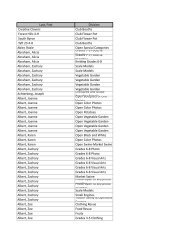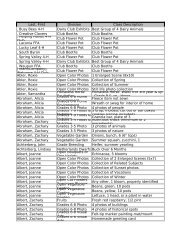FOND DU LAC COUNTY FAIR
FOND DU LAC COUNTY FAIR
FOND DU LAC COUNTY FAIR
Create successful ePaper yourself
Turn your PDF publications into a flip-book with our unique Google optimized e-Paper software.
indirectly in exhibits shown in any department of a fair<br />
be eligible to judge articles or animals in that<br />
department.<br />
(2) Each judge at a county or district fair shall be<br />
provided with a copy of the fair’s premium book or list<br />
of entry classes at least 7 days prior to the opening<br />
date of the fair.<br />
(3) No animal or article, irrespective of the number of<br />
entries in the class in which it is entered, shall be<br />
awarded a higher rating than its merit would entitle it<br />
to in comparison to the standard of perfection in the<br />
class.<br />
(4) (a) No state aid will be paid on premiums awarded<br />
under the Danish system in any classes except in the<br />
junior and educational departments.<br />
(b) When classes in the junior and educational<br />
departments are judged according to the Danish<br />
system, 4 group placings shall be awarded in any<br />
class. When there are less than 8 exhibitors in the<br />
class, there shall not be more than 2 in the first group,<br />
not more than 4 in the first 2 groups and not more<br />
than 6 in the first 3 groups. If there are 8 or more<br />
entries in the class, there shall not be more than 25%<br />
in the first group, not more than 50% in the first 2<br />
groups, and not more than 75% in the first 3 groups.<br />
(c) The number of awards in the last group placing<br />
may be increased to the extent necessary to give<br />
awards to all exhibitors.<br />
(5) If any class of exhibits at a county or district fair is<br />
judged according to the regular system, the judges for<br />
that class may give only one first–place, one second–<br />
place, one third–place and one fourth–place award in<br />
that class.<br />
INTERNATIONAL ASSOCIATION OF <strong>FAIR</strong>S<br />
AND EXPOSITIONS (IAFE) NATIONAL CODE<br />
OF SHOW RING ETHICS<br />
Exhibitors of animals at livestock shows shall at all<br />
times deport themselves with honesty and good<br />
sportsmanship. Their conduct in this competitive<br />
environment shall always reflect the highest<br />
standards of honor and dignity to promote the<br />
advancement of agricultural education. This code<br />
applies to junior as well as open class exhibitors who<br />
compete in structured classes of competition. This<br />
code applies to all livestock offered in any event at a<br />
livestock show. In addition to the “IAFE National Code<br />
of Show Ring Ethics,” fairs and livestock shows may<br />
have rules and regulations, which they impose, on the<br />
local, state, provincial and national levels.<br />
All youth leaders working with junior exhibitors are<br />
under an affirmative responsibility to do more than<br />
avoid improper conduct or questionable acts. Their<br />
moral values must be so certain and positive that<br />
those younger and more pliable will be influenced by<br />
their fine example. Owners, exhibitors, fitters, trainers<br />
and absolutely responsible persons who violate the<br />
code of ethics will forfeit premiums, awards, and<br />
auction proceeds and shall be prohibited from future<br />
exhibition in accordance with the rules adopted by the<br />
respective fairs and livestock shows. Exhibitors who<br />
violate the code of ethics demean the integrity of all<br />
livestock exhibitors and should be prohibited from<br />
competition at livestock shows in the United States<br />
and Canada.<br />
The following is a list of guidelines for all exhibitors<br />
and all livestock in competitive events.<br />
8<br />
1. All exhibitors must present, upon request of fair<br />
and livestock show officials, proof of ownership,<br />
length of ownership and age of all animals<br />
entered. Misrepresentation of ownership, age or<br />
any facts relating thereto is prohibited.<br />
2. Owners, exhibitors, fitters, trainers, or<br />
absolutely responsible persons shall provide<br />
animal health certificates from licensed<br />
veterinarians upon request by fair or livestock<br />
show officials.<br />
3. Junior exhibitors are expected to care for and<br />
groom their animals while at fairs or livestock<br />
shows.<br />
4. Animals shall be presented to show events<br />
where they will enter the food chain free of<br />
violative drug residues. The act of entering an<br />
animal in a livestock show is the giving of<br />
consent by the owner, exhibitor, fitter, trainer<br />
and/or absolutely responsible person for show<br />
management to obtain any specimens of urine,<br />
saliva, blood, or other substances from the animal<br />
to be used in testing. Animals not entered in an<br />
event which culminates with the animal entering<br />
the food chain shall not be administered drugs<br />
other than in accordance with applicable federal,<br />
state and provincial statues, regulations and rules<br />
affect the animal’s performance or appearance at<br />
the event.<br />
If the laboratory report on the analysis of<br />
saliva, urine, blood, or other sample taken from<br />
livestock indicates the presence of forbidden<br />
drugs or medication, this shall be prima facie<br />
evidence such substance has been administered<br />
to the animal either internally or externally. It is<br />
presumed that the sample of urine, saliva, blood<br />
or other substance tested by the laboratory to<br />
which it is sent is the one taken from the animals<br />
in question, its integrity is preserved and all<br />
procedures of said collection and preservation,<br />
transfer to the laboratory and analysis of the<br />
sample are correct and accurate and the report<br />
received from the laboratory pertains to the<br />
sample taken from the animal in question and<br />
correctly reflects the condition of the animal at the<br />
time the sample was taken, with the burden on the<br />
owner, exhibitor, fitter, trainer or absolutely<br />
responsible person to prove otherwise.<br />
At any time after an animal arrives on the fair<br />
or livestock show premises, a licensed<br />
veterinarian shall administer all treatments<br />
involving the use of drugs and/or medications for<br />
the sole purposes of protecting the health of the<br />
animal.<br />
5. Any surgical procedure or injection of any<br />
foreign substance or drug or the external<br />
application of any substance (irritant,<br />
counterirritant, or similar substance) which could<br />
affect the animal’s performance or alter its natural<br />
contour, confirmation, or appearance, except<br />
external applications of substances to the hoofs or<br />
horns of animals which effect appearance only<br />
and except for surgical procedures performed by a<br />
duly licensed veterinarian for the sole purpose of<br />
protecting the health of the animal, is prohibited.<br />
6. The use of showing and /or handling practices<br />
or devices such as striking animals to cause<br />
swelling, using electrical contrivance, or similar<br />
practices are not acceptable and are prohibited.




